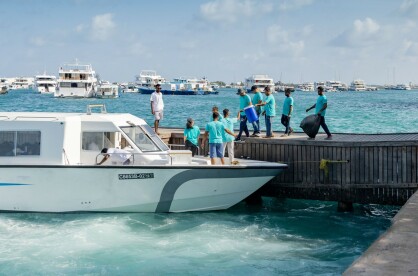In 2021, traffic incidents and violations made up 14 percent of the total cases handled by the Maldives Police Service (MPS). The Maldives Inland Revenue Authority (MIRA) reported a 0.5 percent increase in revenue generated from vehicle fees, raising MVR12 million in January. However, not one single civilian with a vehicle and the licence to drive it would agree that the roads they drive on are acceptable.
Hulhumalé was once an exception, with the introduction of tarred roads for the general populace, but even that novelty has quickly diminished. With the installation of what the public claims are one of the most dangerous and inconsiderate speed bumps by design, the authorities had intended to make road travel safer, but so far, statistics have contested this point.
Bringing the attention back to Malé, the situation has only gotten worse. Ameenee Magu, one of the main roads that crosses the island end-to-end, is a disgrace, with potholes and uneven paving, prone to comparatively extreme flooding whenever it rains. Majeedhee Magu, the main road that cuts through the centre of the island, is a traffic nightmare during peak hours, with congestion untamed. The ring road, Boduthakurufaanu Magu, once known as Marine Drive, has been tarred to an extent, but even then, with an paved section and its collection of potholes and uneven surfaces, has been cause for concern in the public.
The appalling situation is made worse when the vehicles in motion require space to stop. Parking is a constant dilemma in Malé, with the recently elected city council making meagre efforts to establish open spaces for motorbike parking, where multi-storey complexes could have addressed the issue better. They had claimed lack of funding from the government but… they are the government, too, in the eyes of the public that elected them to serve.
Yet the Police spends exceptional amounts of time and excruciating attention to any and every traffic violation, especially parking. While the people protest the fees being paid for vehicles with no improvements in road conditions, the Police celebrate the immense amounts of fines they collect for the state. While they are in the right in the eyes of the law to give citations out to people who park in prohibited areas, the people have little choice in the matter.
At the time of this article, no substantial study has been done to truly assess the severity of this situation. There are no easy ways to figure out how many vehicles have been registered in this tiny, congested city of 200,000 people. There isn’t enough space on the sides of the roads to legally park and secure the vehicles, while allowing smooth access through the alleyways. There is barely enough effort by the authorities to improve the roads which have been in this state of disrepair for nearly a decade already. And, from the experiences of the people, the unevenness of the streets has contributed more to vehicular deterioration than individual negligence.
The Malé City Council, along with the Ministry of Transport and Civil Aviation, had, since 2018, spoken about their intentions to curb the exponential growth in the numbers of vehicles on the streets, but so far, the burden falls upon the consumers. Now, with the heartbreaking loss of a poor soul to a traffic incident that could have been avoided, the topic appears to have been dusted off and revived.
Multiple narrow streets have been converted to non-parking areas, with the neat double-lines on the street sides, but desperation requires drivers to violate this rule. The lack of public transport options, least of all the lack of initiatives by the authorities in this regard, force civilians to depend on personal transport options, except perhaps for travel across the Greater Malé Region.
The people are speaking of how finally the dangerous speed bumps in Hulhumalé are being repainted for the safety of the drivers, but such upkeep is long overdue. With so much money rolling in due to fines and licensing fees, it is a curious state of affairs when the council themselves claim they are being held back due to financing issues. It has become a reality of much irony with the latest request by the city council for third party investors to build multi-level, mixed-used parking zones, so where has all the road-worthiness and annual fees gone?
A solution at this juncture is not simple. The mistakes made before have been left unfixed for too long that an overnight policy change would cause more harm than good if aired, yet the onus keeps falling on the citizens. The recent change to driving school and licence examination policies force new students to spend 40 hours in such a school to prove one’s competency before they’re even put on the examination roll. While this is a necessary change, this was not the cure of the issue.
The recent injury to a safe and law-abiding driver who slid on construction debris scattered over tarred roads is one of many situations that could have been avoided yet still racks up the statistics. Administrative negligence could be lumped with vicarious liability for workers working under contract for the government such as those in Hulhumalé phase 2, yet this is a lost cause in the Maldives.
The Maldivian government demands, with hefty fines as punitive methods, a road worthiness guarantee of vehicles, yet the roads are not worthy. The paved streets are slippery and pose much danger in the best of circumstances, and the uneven surfaces contribute to the detrimental effect on the health of daily drivers and commuters.
The city council and other similar council offices claim that more could be done in service of the people if the Local Government laws were adjusted to allow them financial independence from the central government, and this could most possibly be the solution to this ailment. Furthermore, it has been suggested in political discourse that even the fees and fines paid with regard to traffic need be diverted to the relative councils, as the roads themselves fall within the responsibility of these entities.
However, change does not seem to alight on the horizon. Road safety and even proper parking has become the burden of the people themselves, regardless of the checks and balances on paper rather than practice. Some narrow streets have been rebuilt based on fancy plans, yet the changes end up causing more problems than it was supposed to fix in the first place, such as Roashanee Magu in Henveiru. The street was given pavements on either side and Victorian street lamps, yet now four-wheeled vehicles are forced to tip to a side and drive with one side of wheels on the pavement.
Road safety has been taught in schools for decades, yet the greatest danger currently lies not in the number of irresponsible, reckless drivers, but neglected roads and streets. The question that arises now is, how many lives must be lost for change to truly occur?







